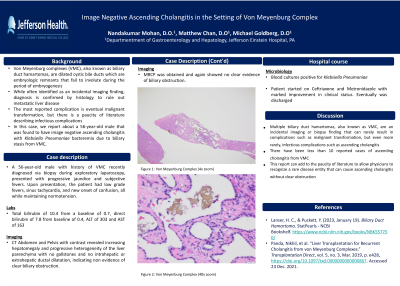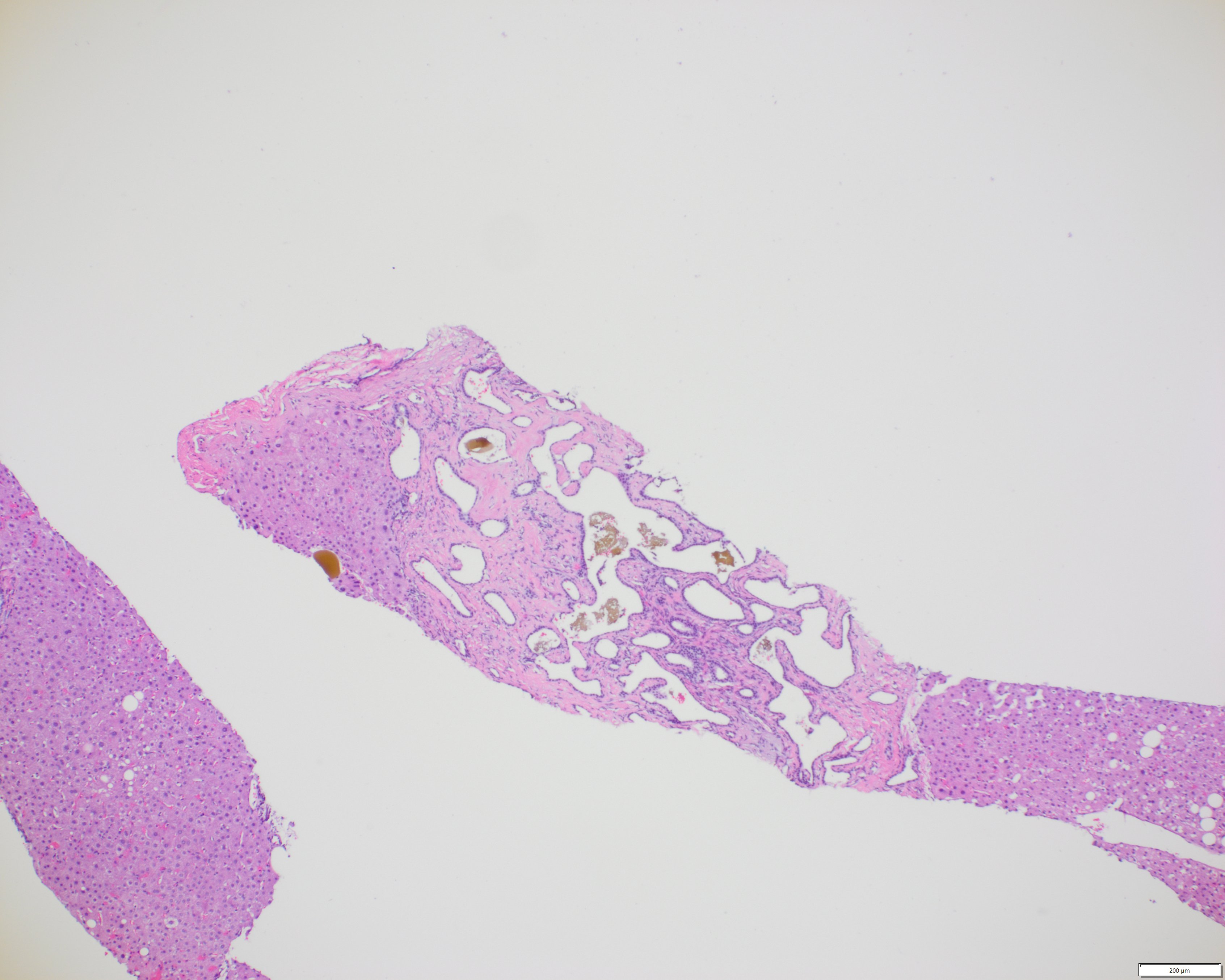Tuesday Poster Session
Category: Biliary/Pancreas
P3612 - Image Negative Ascending Cholangitis in the Setting of Von Meyenburg Complex
Tuesday, October 29, 2024
10:30 AM - 4:00 PM ET
Location: Exhibit Hall E

Has Audio

Nandakumar Mohan, DO
Einstein Healthcare Network
Philadelphia, PA
Presenting Author(s)
Nandakumar Mohan, DO1, Matthew Chan, DO2, Michael Goldberg, DO3
1Einstein Healthcare Network, Philadelphia, PA; 2Einstein Healthcare Network, East Norriton, PA; 3Albert Einstein Medical Center, Philadelphia, PA
Introduction: Von Meyenburg complexes (VMC), also known as biliary duct hamartomas, are dilated cystic bile ducts which are embryologic remnants that fail to involute during the period of embryogenesis. While often identified as an incidental imaging finding, diagnosis is confirmed by histology to rule out metastatic liver disease. The most reported complication is eventual malignant transformation, but there is a paucity of literature describing infectious complications. In this case, we report about a 56-year-old male that was found to have image negative ascending cholangitis with Klebsiella Pneumoniae bacteremia due to biliary stasis from VMC.
Case Description/Methods: A 56-year-old male with history of VMC recently diagnosed via biopsy during exploratory laparoscopy, presented with progressive jaundice and subjective fevers. Upon presentation, the patient had low grade fevers, sinus tachycardia, and new onset of confusion, all while maintaining normotension. Labs were significant for total bilirubin of 10.4 from a baseline of 0.7, direct bilirubin of 7.8 from baseline of 0.4, ALT of 303 and AST of 163. CT Abdomen and Pelvis with contrast revealed increasing hepatomegaly and progressive heterogeneity of the liver parenchyma with no gallstones and no intrahepatic or extrahepatic ductal dilatation, indicating non evidence of clear biliary obstruction. Patient was commenced on Ceftriaxone and Metronidazole for presumed ascending cholangitis. MRCP was obtained and again showed no clear evidence of biliary obstruction. Blood cultures returned positive for Klebsiella Pneumoniae. Infectious disease and Gastroenterology agreed that the only clear infectious source was biliary stasis from known VMC. Over the next few days, the patient exhibited improving clinical status along with fever resolution and bilirubin improvement.
Discussion: Multiple biliary duct hamartomas, also known as VMC, are an incidental imaging or biopsy finding that can rarely result in complications such as malignant transformation, but even more rarely, infectious complications such as ascending cholangitis. There have been less than 10 reported cases of ascending cholangitis from VMC. This report can add to the paucity of literature to allow physicians to recognize a rare disease entity that can cause ascending cholangitis without clear obstruction.

Disclosures:
Nandakumar Mohan, DO1, Matthew Chan, DO2, Michael Goldberg, DO3. P3612 - Image Negative Ascending Cholangitis in the Setting of Von Meyenburg Complex, ACG 2024 Annual Scientific Meeting Abstracts. Philadelphia, PA: American College of Gastroenterology.
1Einstein Healthcare Network, Philadelphia, PA; 2Einstein Healthcare Network, East Norriton, PA; 3Albert Einstein Medical Center, Philadelphia, PA
Introduction: Von Meyenburg complexes (VMC), also known as biliary duct hamartomas, are dilated cystic bile ducts which are embryologic remnants that fail to involute during the period of embryogenesis. While often identified as an incidental imaging finding, diagnosis is confirmed by histology to rule out metastatic liver disease. The most reported complication is eventual malignant transformation, but there is a paucity of literature describing infectious complications. In this case, we report about a 56-year-old male that was found to have image negative ascending cholangitis with Klebsiella Pneumoniae bacteremia due to biliary stasis from VMC.
Case Description/Methods: A 56-year-old male with history of VMC recently diagnosed via biopsy during exploratory laparoscopy, presented with progressive jaundice and subjective fevers. Upon presentation, the patient had low grade fevers, sinus tachycardia, and new onset of confusion, all while maintaining normotension. Labs were significant for total bilirubin of 10.4 from a baseline of 0.7, direct bilirubin of 7.8 from baseline of 0.4, ALT of 303 and AST of 163. CT Abdomen and Pelvis with contrast revealed increasing hepatomegaly and progressive heterogeneity of the liver parenchyma with no gallstones and no intrahepatic or extrahepatic ductal dilatation, indicating non evidence of clear biliary obstruction. Patient was commenced on Ceftriaxone and Metronidazole for presumed ascending cholangitis. MRCP was obtained and again showed no clear evidence of biliary obstruction. Blood cultures returned positive for Klebsiella Pneumoniae. Infectious disease and Gastroenterology agreed that the only clear infectious source was biliary stasis from known VMC. Over the next few days, the patient exhibited improving clinical status along with fever resolution and bilirubin improvement.
Discussion: Multiple biliary duct hamartomas, also known as VMC, are an incidental imaging or biopsy finding that can rarely result in complications such as malignant transformation, but even more rarely, infectious complications such as ascending cholangitis. There have been less than 10 reported cases of ascending cholangitis from VMC. This report can add to the paucity of literature to allow physicians to recognize a rare disease entity that can cause ascending cholangitis without clear obstruction.

Figure: Bile Duct Hamartoma
Disclosures:
Nandakumar Mohan indicated no relevant financial relationships.
Matthew Chan indicated no relevant financial relationships.
Michael Goldberg indicated no relevant financial relationships.
Nandakumar Mohan, DO1, Matthew Chan, DO2, Michael Goldberg, DO3. P3612 - Image Negative Ascending Cholangitis in the Setting of Von Meyenburg Complex, ACG 2024 Annual Scientific Meeting Abstracts. Philadelphia, PA: American College of Gastroenterology.
